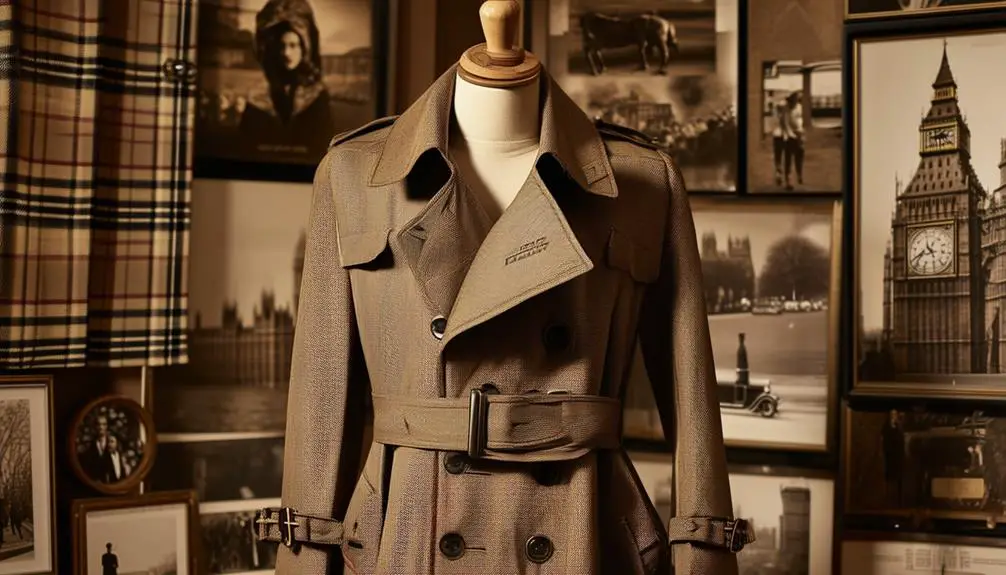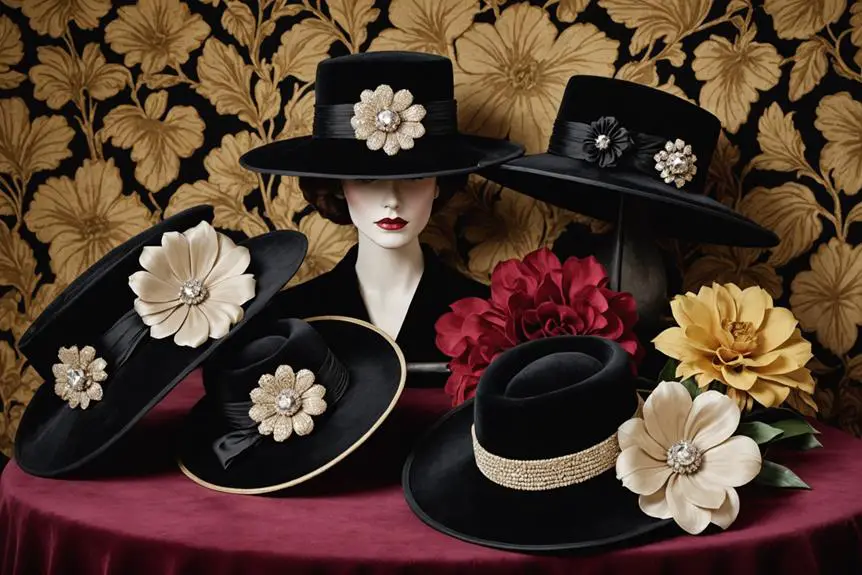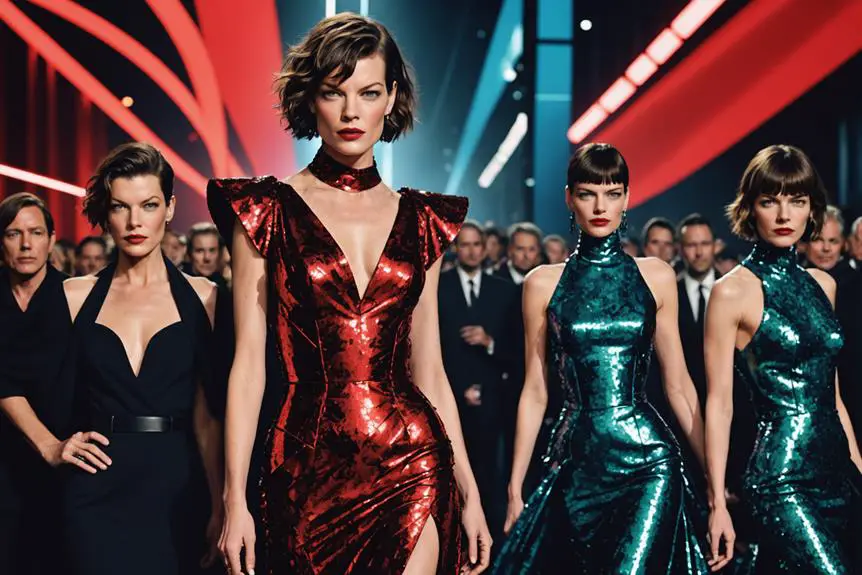Burberry's history illustrates its evolution from a modest outdoor apparel brand to a prestigious global luxury icon. Established by Thomas Burberry in 1856, the brand transformed outerwear with the creation of gabardine, a breathable and waterproof fabric. Its prominence surged during World War I with the introduction of the trench coat, designed for military functionality. Royal endorsements further heightened its status, while contemporary leadership embraced digital innovation, enhancing e-commerce and sustainability initiatives. Nonetheless, the brand has faced challenges related to ethics and supply chain practices that have put its reputation to the test. As Burberry navigates these hurdles, the story of its resilience and adaptation continues to captivate fashion enthusiasts.
Founding and Early Innovations
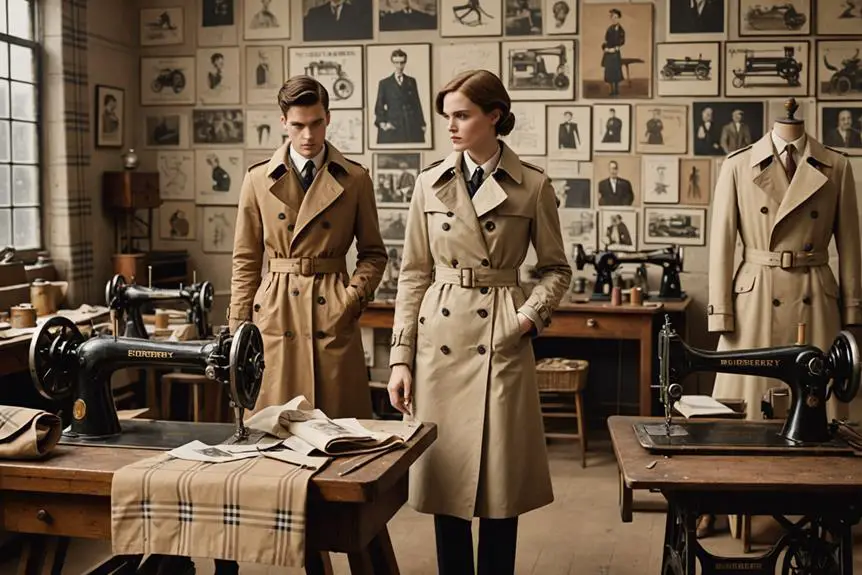
Burberry's founding in 1856 marked the beginning of a transformative journey in outdoor apparel. At just 21, founder Thomas Burberry recognized the need for innovative weather protection in England's unpredictable climate. His vision led to the creation of outdoor attire that combined functionality with style. In 1879, he invented gabardine—a revolutionary breathable and weatherproof fabric that would become a cornerstone of the brand. This innovation was patented in 1888, establishing Burberry as a leader in protective clothing.
The brand's reputation soared in 1893 when polar explorer Dr. Fridtjof Nansen donned Burberry gabardine during his Arctic expedition, proving its durability in extreme conditions. This association with adventure and exploration solidified Burberry's status in the outdoor apparel market. Around 1901, fueled by public interest, the iconic equestrian knight logo emerged, symbolizing the brand's commitment to protection and innovation.
The Tielocken coat, patented in 1912, set the stage for the iconic trench coat, designed specifically for soldiers during World War I. Each of these early innovations not only defined Burberry's identity but also laid the groundwork for its enduring legacy in fashion.
Military Influence and Design
During World War I, the demand for functional and durable clothing reached new heights, prompting designers to create garments that could withstand the rigors of battle. The Burberry trench coat emerged as a quintessential piece of military apparel, incorporating practical features like epaulettes and D-rings for equipment attachment. This design not only served the needs of soldiers but also represented a shift towards utility and protection in fashion.
Notably, Sir Ernest Shackleton wore Burberry's gabardine fabric during his Antarctic expeditions, further cementing the brand's reputation for durability in extreme conditions. The Tielocken coat, patented by Thomas Burberry in 1912, laid the groundwork for the trench coat, showcasing early military-inspired designs that prioritized functionality.
Burberry continued to reinforce its commitment to the British Armed Forces by supplying military apparel during World War II, proving its ability to deliver weatherproof clothing suitable for harsh environments. The innovative gabardine fabric, invented in 1879, became essential for military uniforms, valued for its breathability and water-resistance. Within this framework, Burberry not only shaped military fashion but also contributed to the exploration narrative, embodying the spirit of adventure and resilience.
Royal Recognition and Growth
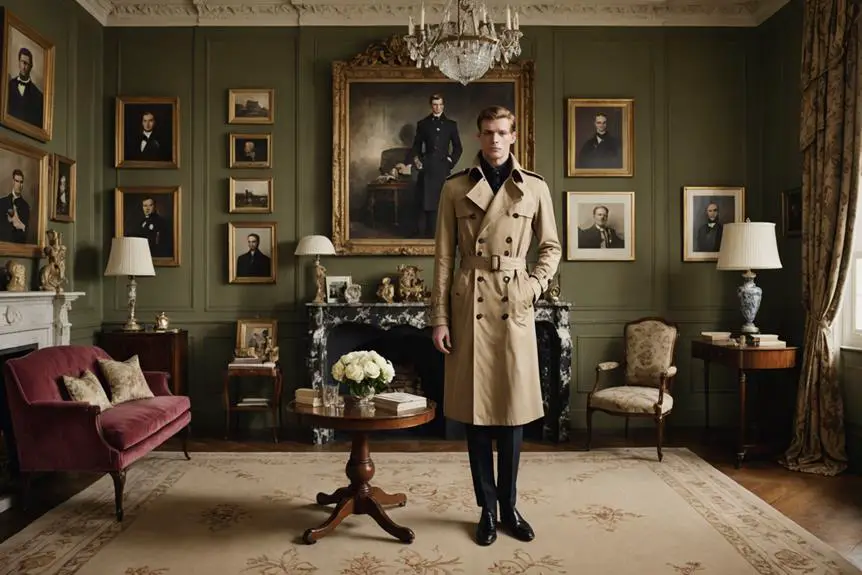
Achieving royal recognition greatly elevated Burberry's status in the world of fashion, marking a pivotal moment in its history. In 1955, receiving a Royal Warrant from HM Queen Elizabeth II as a Weatherproofer solidified Burberry's reputation as a hallmark of luxury fashion and British heritage. This prestigious endorsement not only enhanced its brand image but also underscored its commitment to quality and craftsmanship.
By 1965, consumer demand skyrocketed, with one in five coats exported from Britain bearing the Burberry label. This surge in international demand prompted strategic growth, including the acquisition of the Castleford factory in 1972, which bolstered Burberry's manufacturing presence in the UK and reaffirmed its dedication to local production.
The brand's prestige continued to soar with a second Royal Warrant granted by HRH The Prince of Wales in 1990 as an Outfitter, adding to its royal accolades. Retail expansion took a significant leap in 2000 with the opening of its first store on Bond Street, making the iconic brand more accessible to consumers. Together, these milestones crafted Burberry's identity as a leader in luxury fashion, seamlessly blending tradition with modern appeal.
Modernization and Digital Strategy
The evolution of Burberry into a modern luxury brand reflects its proactive approach to embracing new technologies and consumer behaviors. Under Christopher Bailey's leadership since 2001, Burberry has made significant strides in modernization and digital strategy.
Here are four key developments that shaped this transformation:
- Pioneering Digital Engagement: In 2010, Burberry became the first luxury brand to livestream a fashion show, showcasing its commitment to innovative marketing.
- E-commerce Growth: By 2011, Burberry's online retail distribution soared from 43% to 64%, underlining a strategic shift towards e-commerce and global accessibility.
- Technologically Advanced Flagship Store: The opening of the flagship store at 121 Regent Street in 2012 integrated cutting-edge technology, enhancing customer interactions and providing a unique shopping experience.
- Social Retail Innovation: In 2020, the launch of Burberry's first Social Retail store in Shenzhen exemplified its blend of physical retail and social media, adapting to evolving consumer habits.
Through these initiatives, Burberry not only modernized its operations but also solidified its status as a forward-thinking luxury brand that prioritizes consumer engagement in this digital age.
Sustainability Initiatives
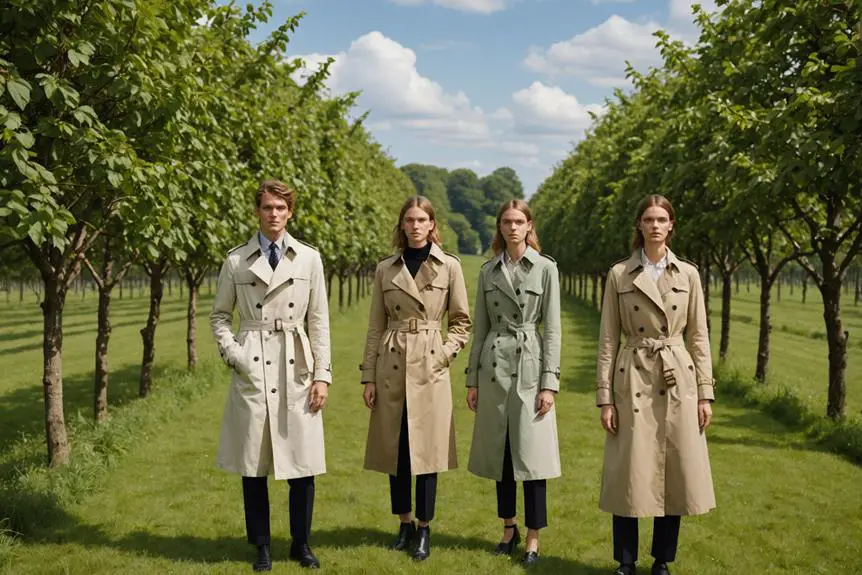
Embracing sustainability has become a cornerstone of Burberry's brand identity as the luxury fashion house shifts toward more responsible practices. The establishment of the Material Futures Research Group in 2017, in collaboration with the Royal College of Art, underscores Burberry's commitment to innovating sustainable materials. This initiative reflects a broader movement within the industry to reduce carbon emissions and enhance sustainable practices.
By 2018, Burberry took significant steps, committing to phase out real fur and announcing plans to eliminate exotic skins by 2022. These bold decisions not only align with evolving consumer expectations but also demonstrate a dedication to ethical fashion. Aiming for climate positivity by 2040, Burberry targets a 46% reduction in supply chain emissions by 2030, highlighting its ambition to lead in sustainability.
The brand's Rainbow Vintage check collection launched in 2018, serves as a symbol of diversity and inclusivity, reinforcing the connection between sustainability and social responsibility. Additionally, the Burberry Foundation, established in 2008, supports youth creativity and promotes sustainable practices, ensuring that the next generation is engaged in responsible fashion. Together, these initiatives illustrate Burberry's proactive stance in shaping a more sustainable future.
Cultural Impact and Marketing
Burberry's commitment to sustainability not only shapes its ethical framework but also enhances its cultural resonance in the fashion landscape. The brand's rich history, particularly with the trench coat, has solidified its status as a symbol of British luxury and identity. Burberry's marketing strategies have evolved, embracing collaborations that connect with diverse audiences and contemporary culture.
Here are four key aspects of Burberry's cultural impact and marketing:
- Collaborations: Partnering with artists like Raheem Sterling and Kano, Burberry blends fashion with music, fostering cultural relevance.
- Burberry Rainbow Check: Launched in 2018, this collection promotes diversity and inclusivity, reflecting the brand's social responsibility.
- Visibility through Media: Featuring British models and musicians has led to a 310% increase in Google searches, showcasing the power of popular media in driving interest.
- Rebranding Efforts: The reinstatement of the Equestrian Knight logo in 2023 highlights a modern interpretation of British luxury while staying true to its heritage.
Through these initiatives, Burberry not only maintains its iconic status but also adapts to a changing cultural landscape.
Leadership Changes Over Time
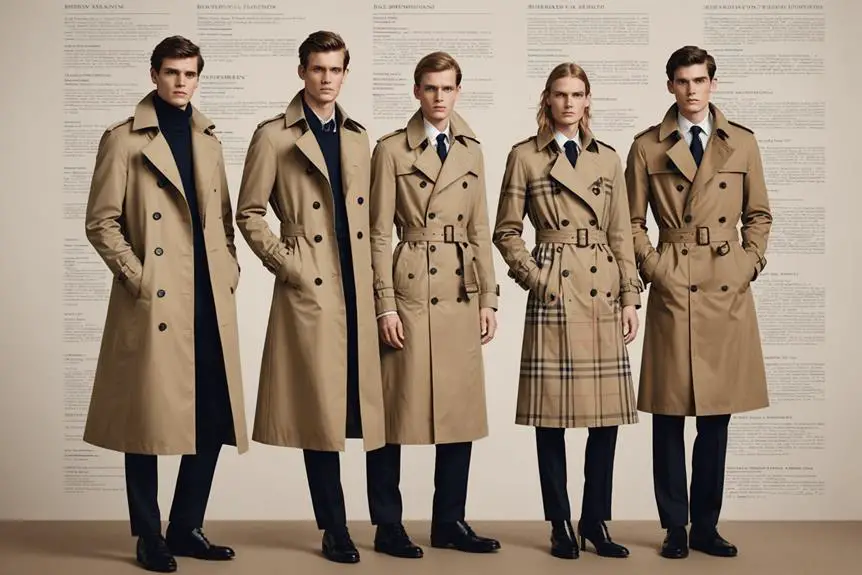
Throughout its history, Burberry has seen a series of leadership changes that have greatly influenced its trajectory. Christopher Bailey, who joined as creative director in 2001 before becoming CEO, was instrumental in revamping the brand image and integrating a digital strategy that modernized Burberry's appeal. His tenure set the stage for future transformations.
In 2006, Angela Ahrendts took over as CEO, guiding Burberry through significant growth and global expansion until 2014. Her leadership emphasized the luxury brand's global presence, solidifying its status. Following her, Marco Gobbetti was appointed CEO in 2016, focusing on enhancing Burberry's luxury positioning and initiating strategic changes to elevate the brand further.
In 2018, Riccardo Tisci joined as chief creative officer, introducing a new logo and monogram while steering the brand towards modern inclusivity, reflecting contemporary consumer values. Most recently, in April 2022, Jonathan Akeroyd replaced Gobbetti, implementing strategic changes, including job cuts, to improve profitability amidst challenging market conditions. Each leader's vision has shaped Burberry's evolution, ensuring its relevance in the competitive luxury landscape.
Legal and Ethical Challenges
The luxury brand landscape is not without its legal and ethical complexities, and Burberry has faced its share of challenges in these areas. As a prominent player in fashion, you need to be aware of the hurdles it has encountered, particularly concerning ethical concerns and sustainability.
- In 2018, Burberry filed a lawsuit against Target for allegedly copying its check print designs, reinforcing its commitment to intellectual property protection.
- Accusations in 2023 linked Burberry's supply chain to forced labor in Uyghur camps, raising significant ethical concerns that jeopardize brand reputation.
- To uphold brand integrity, Burberry destroyed unsold goods worth over £90 million in 2018, igniting debates about waste and sustainability in the industry.
- However, Burberry has made strides by committing to phase out real fur by September 2018 and exotic skins by May 2022, illustrating a shift toward more ethical sourcing practices.
Amidst these legal and ethical challenges, Burberry aims for climate positivity by 2040, pledging to reduce supply chain emissions by 46% by 2030. This commitment highlights the brand's ongoing struggle to balance luxury with responsibility.
Financial Performance Insights
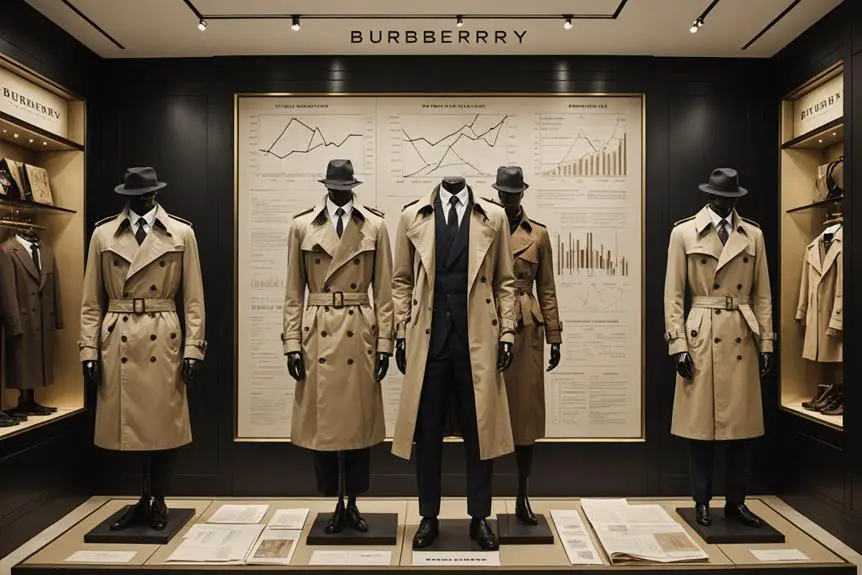
Amid shifting market conditions, Burberry's financial performance reflects both resilience and vulnerability in the luxury sector. In July 2024, the brand faced a significant sales decline across various markets, prompting a strategic review to address its operational challenges. The COVID-19 pandemic specifically impacted sales in China, underscoring the fragility of luxury brands during global crises.
However, positive media impact has bolstered Burberry's brand visibility. Following a prominent appearance in the television series "Succession" on March 29, 2023, the company saw a staggering 310% increase in Google searches for its products, revealing how consumer perception can shift rapidly. This highlights the intricate relationship between media exposure and brand desirability.
Despite these ups and downs, Burberry's past indicates potential for recovery. After Christopher Bailey's exit as CEO in May 2017, the brand experienced a resurgence in sales, suggesting a renewed demand. To enhance profitability amid financial strains, Burberry also announced global job cuts of 500 positions in July 2020, aiming to save £55 million. These moves illustrate the brand's ongoing efforts to navigate the complex landscape of luxury retail while working towards stability and growth.
Product Innovations and Designs
Since its inception, Burberry has consistently pushed the boundaries of innovation in product design, establishing itself as a leader in the luxury fashion industry. The brand's commitment to functional design and sustainability has redefined outerwear and set industry standards. Here are four key innovations that underscore Burberry's legacy:
- Gabardine: Invented in 1879, this was the world's first breathable and weatherproof fabric, revolutionizing rainwear.
- Trench Coat: Originally designed for military use during WWI, it features practical elements like epaulettes and D-rings, blending style with functionality.
- Burberry Check: Introduced in the 1920s as a lining for trench coats, this iconic pattern has become a global symbol of the brand's identity.
- Sustainable Practices: In 2019, Burberry reimagined its packaging using recycled coffee cups, recycling 58 million cups, showcasing its dedication to sustainability.
Burberry's adaptability was further highlighted during the COVID-19 pandemic when it retooled factories to produce PPE. By integrating product innovation with a strong ethical framework, Burberry continues to shape the future of luxury fashion.
Frequently Asked Questions
What Is the Story Behind Burberry?
You'll find Burberry's story weaves together innovation and tradition, highlighting its commitment to quality. From pioneering fabrics to iconic designs, the brand embodies a rich legacy that continues to influence fashion and luxury today.
What Does Burberry Symbolize?
Burberry symbolizes British heritage, innovation, and luxury. Its iconic designs reflect functionality and style, while its commitment to sustainability showcases modern values. You'll find that the brand embodies a blend of tradition and contemporary ethics.
What Are Key Facts About Burberry?
Burberry's key facts include its founding in 1856, the invention of gabardine, the iconic trench coat's military design, the introduction of the Burberry check, and being the first luxury brand to livestream a fashion show.
What Is Burberry Most Famous For?
You'll find Burberry most famous for its iconic trench coat, a blend of style and practicality. Its distinctive check pattern and innovative gabardine fabric further solidify its status as a timeless luxury brand in fashion.
